This post may contain affiliate links. Please read my privacy policy.
Sambal is the building block of Malaysian cooking, and this easy sambal recipe is the real deal. Learn how to make homemade sambal to bring its spicy, bold, and aromatic flavors to your dishes. Whether you’re a pro in the kitchen or just a beginner, sambal adds an exciting kick to your cooking. Get ready to spice up your meals with authentic Malaysian sambal!
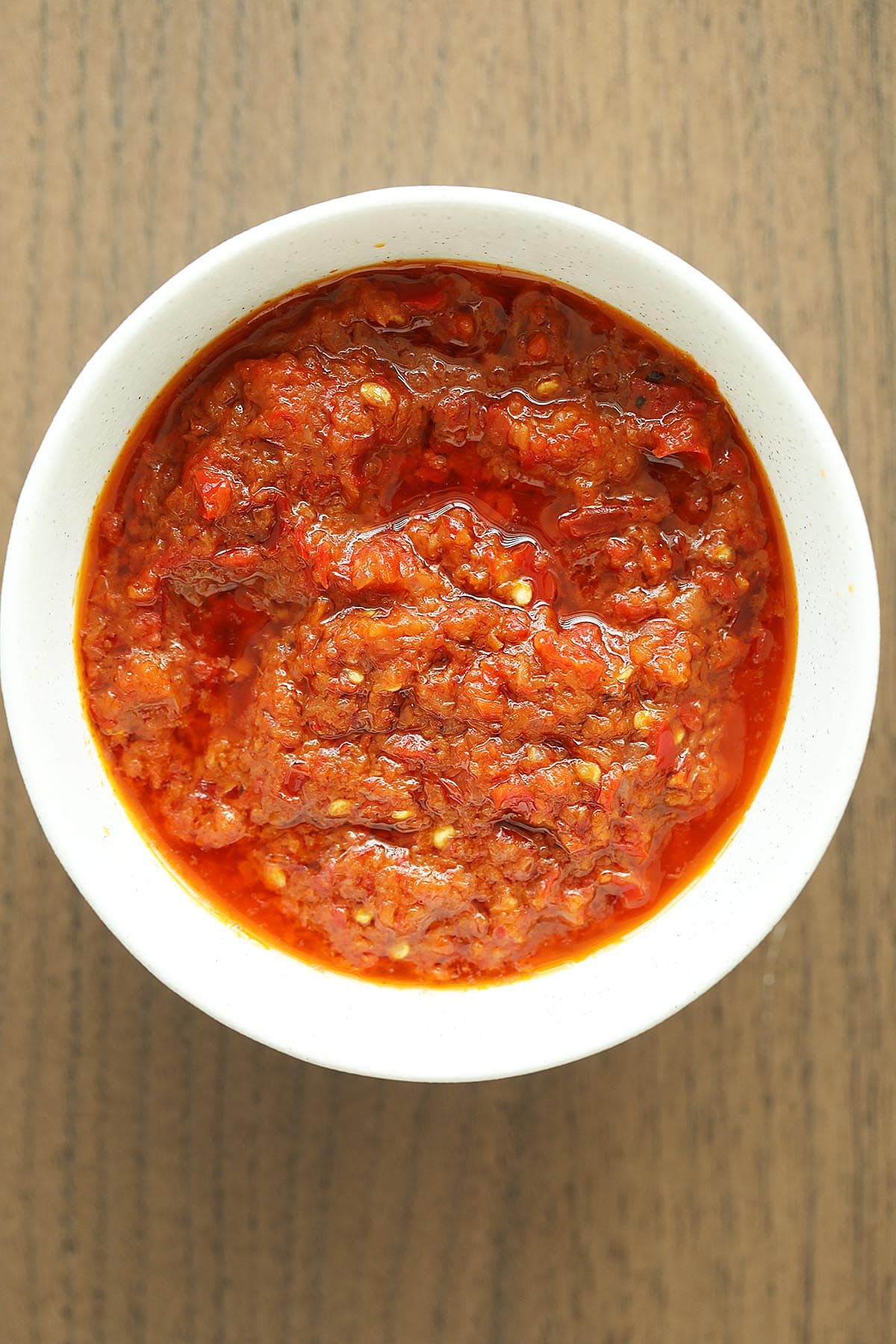
What Is Sambal
Sambal is a versatile and spicy condiment commonly found in Southeast Asian cuisine, particularly in countries like Malaysia, Indonesia, and Singapore. It typically consists of chili peppers as the main ingredient, which are blended or pounded into a spice paste with various other ingredients such as garlic, shallots, shrimp paste (belacan). Salt, sugar or other seasonings may be added depending on the recipe.
There are many variations of sambal, each with its own unique flavor profile and level of spiciness. It can range from mild to extremely hot, depending on the types of chili peppers used. Thai chilies or bird’s eye chilies are added to increase the heat level.
Traditionally, sambal in Malaysia is prepared fresh or purchased ready-made from local wet markets and used immediately in cooking. In the US, I prefer to make sambal into a paste that I can conveniently store in the refrigerator and use as needed. Using more dried chilies in my sambal recipe helps extend its shelf life. The fresh red chilies give a nice red color as dried red chilies look duller in color.
Simply put, sambal is the heart and soul of Malaysian cooking. It’s what gives authentic Malaysian dishes their bold, spicy flavor—you can’t do without it!
Sambal Main Ingredients
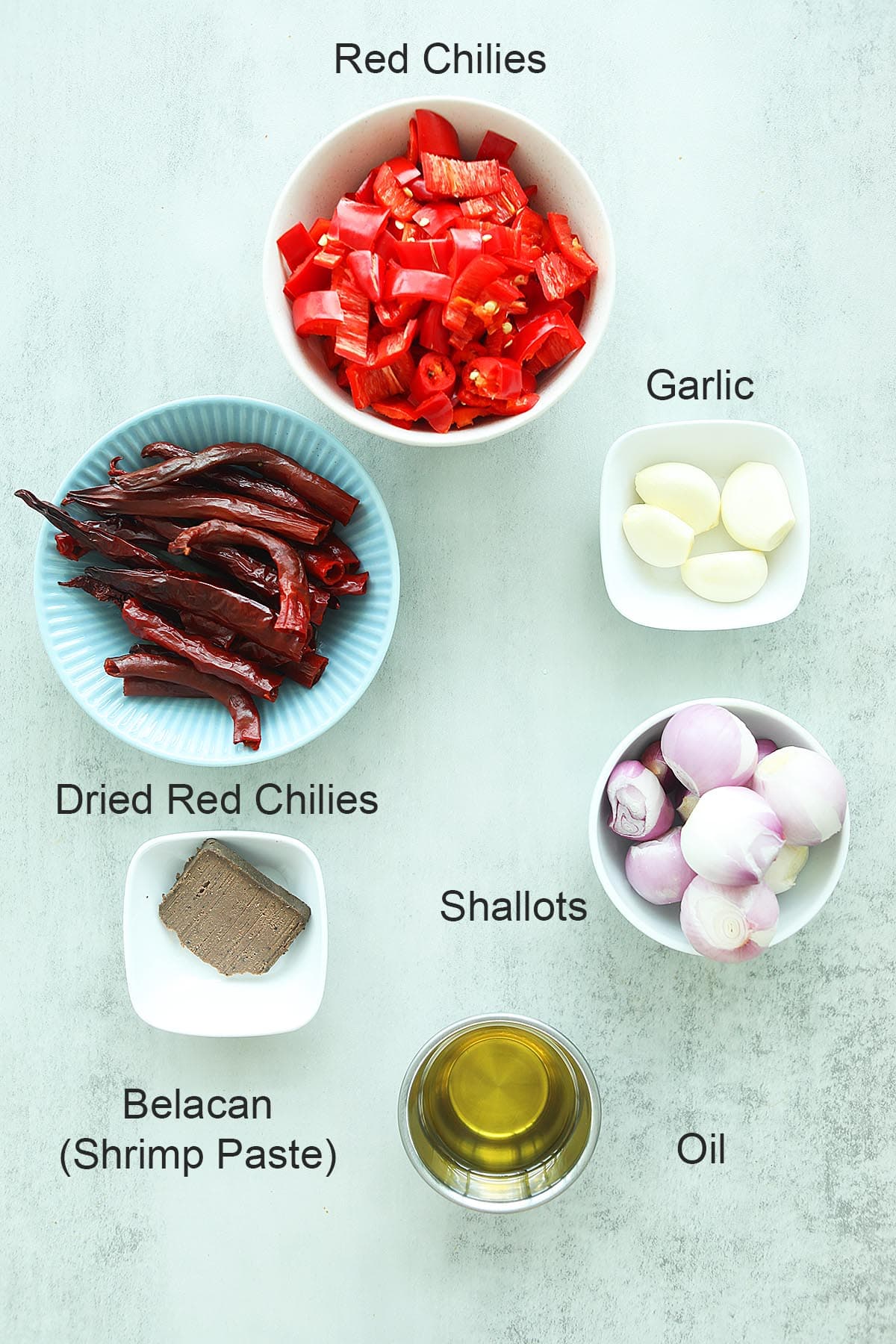
My recipe calls for the following ingredients main ingredients:
- Fresh red chilies – adds vibrant red colors to sambal, it also tames down the heat level as fresh red chilies are less spicy as dried red chilies.
- Dried red chilies – the heat level comes from dried red chilies. I like to balance my sambal with a combination of fresh and dried red chilies, for the best texture and flavor profile.
- Shallots – this is quintessential in any sambal recipe. If you cannot find shallots, you may use red onions.
- Garlic – even though it’s optional, I like to use some garlic in my sambal recipe for extra garlicky note.
- Belacan or Malaysian shrimp paste – the umami bomb in Malaysian sambal. A sambal is not authentic without pungent belacan.
- Oil – oil is essential in Malaysian cooking to sauté or “tumis” the sambal until the oil separates from the paste, a process known as “pecah minyak” in Malay language. This step is crucial as it intensifies the flavors and ensures the sambal is fully cooked, resulting in what is known as “sambal tumis.”
Culinary Uses Of Sambal
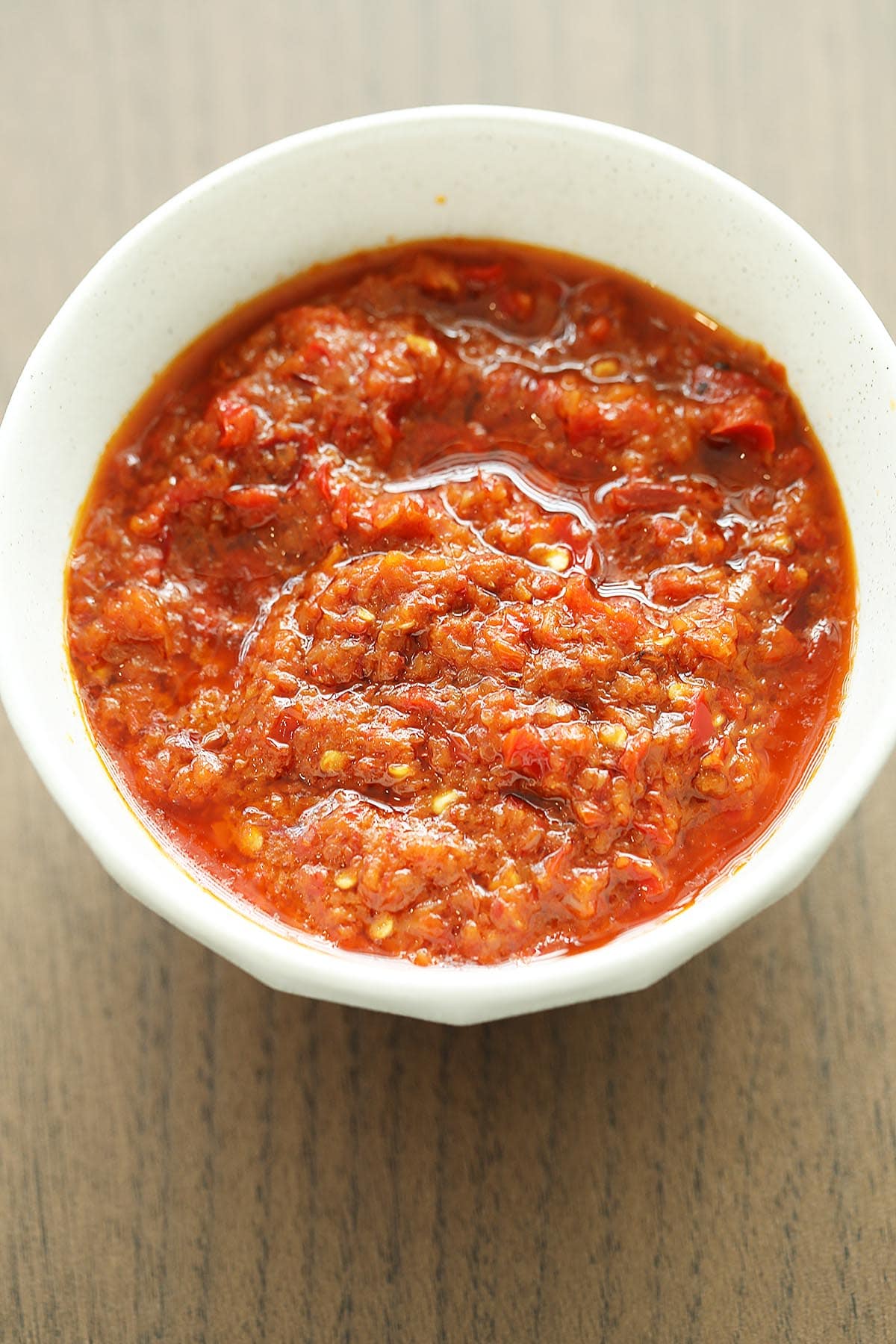
Sambal is a versatile condiment with numerous culinary uses across Malaysian cuisine. Here are some common ways sambal is used in cooking:
- Condiment: Sambal is often served as a condiment alongside dishes like rice, noodles, meat, chicken, and seafood. It adds a spicy kick and enhances the overall flavor of the dish. Fresh and uncooked sambal is called sambal belacan in Malaysia.
- Stir-Fries: Sambal is an excellent base for stir-fries. It provides both heat and depth of flavor to vegetables such as sambal okra, sambal asparagus, and sambal eggplant. It’s also great with shrimp, fish and egg, like prawn sambal, asam pedas fish, and egg sambal.
- Rice and Noodle Dishes: Sambal is a popular condiment to nasi lemak, as well as to noodle dishes such as mee goreng (fried noodles) and nasi goreng (fried rice), and Soto Ayam. It can be added to the dish during the cooking process, or served as a condiment on the side.
- Dipping Sauce: Mixed with soy sauce, tamarind juice, sliced shallots, red chilies, or bird’s eye chilies, sambal becomes an amazing dipping sauce for classic Malaysian dish like grilled fish with banana leaf.
These examples show how sambal adds spicy heat, depth, and flavor complexity to a variety of dishes. Its culinary possibilities are endless!
How To Make Sambal
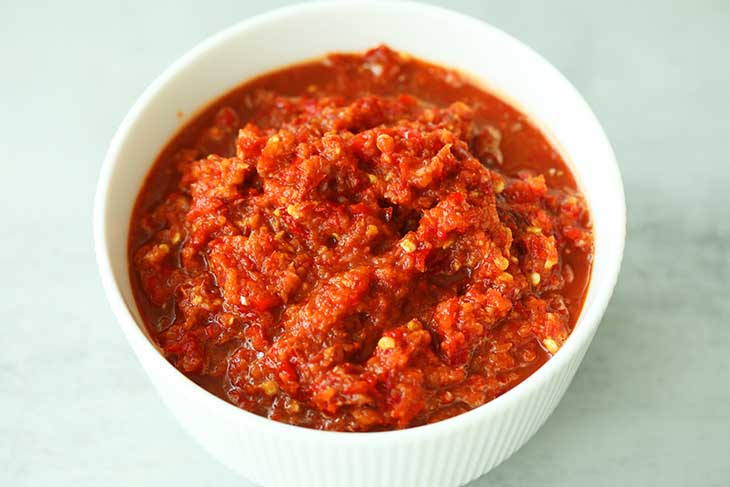
Step 1: Use a mortar and pestle to pound the sambal ingredients thoroughly, or opt for a food processor to blend them evenly in a fine and smooth sambal paste.
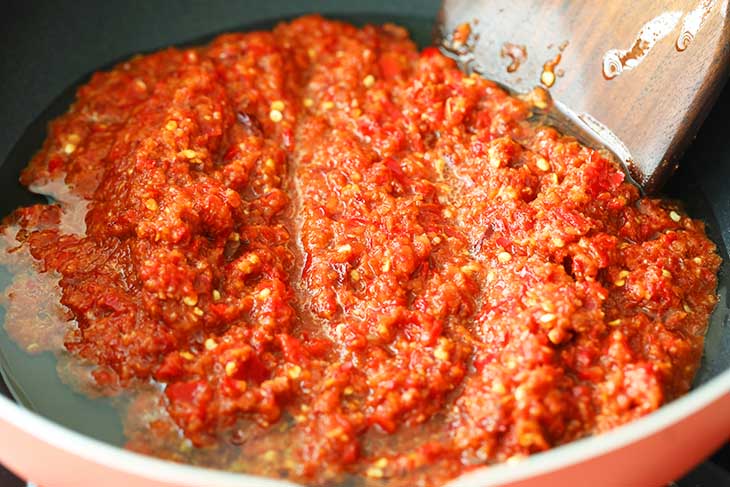
Step 2: On medium heat, Heat oil in a wok until hot. Add the sambal paste to the wok and stir-fry continuously for a few minutes.
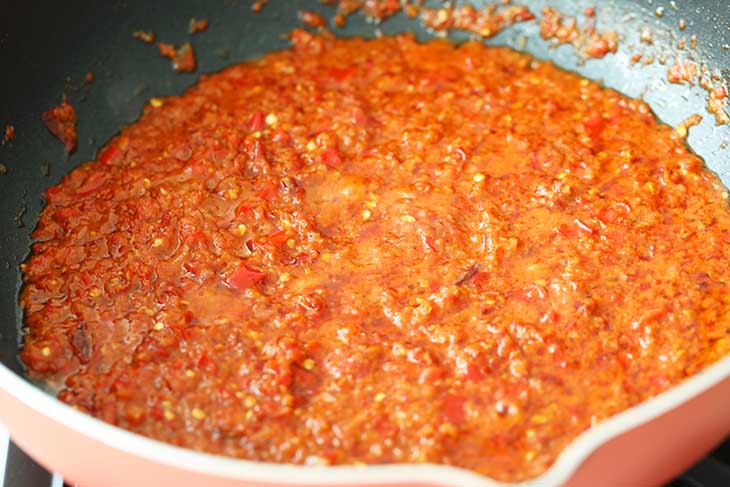
Step 3: Make sure the oil separates from the sambal.
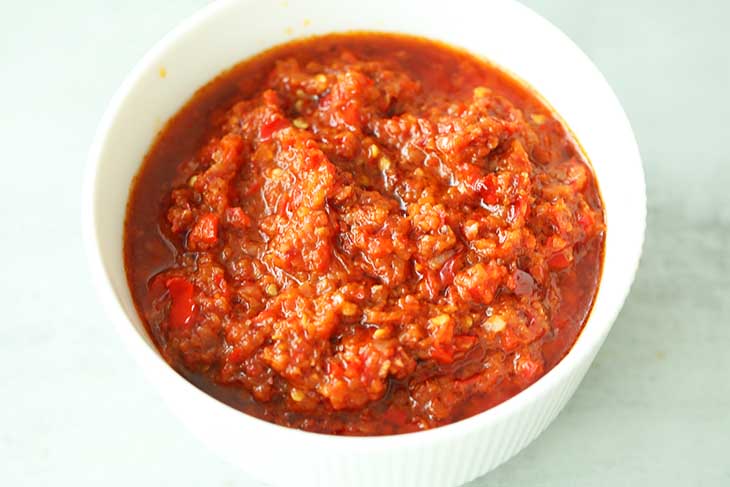
Step 4: Remove from heat and transfer to a bowl. Let it cool before storing in an airtight container. Keep in the refrigerator for future use.
Helpful Tips For Beginner
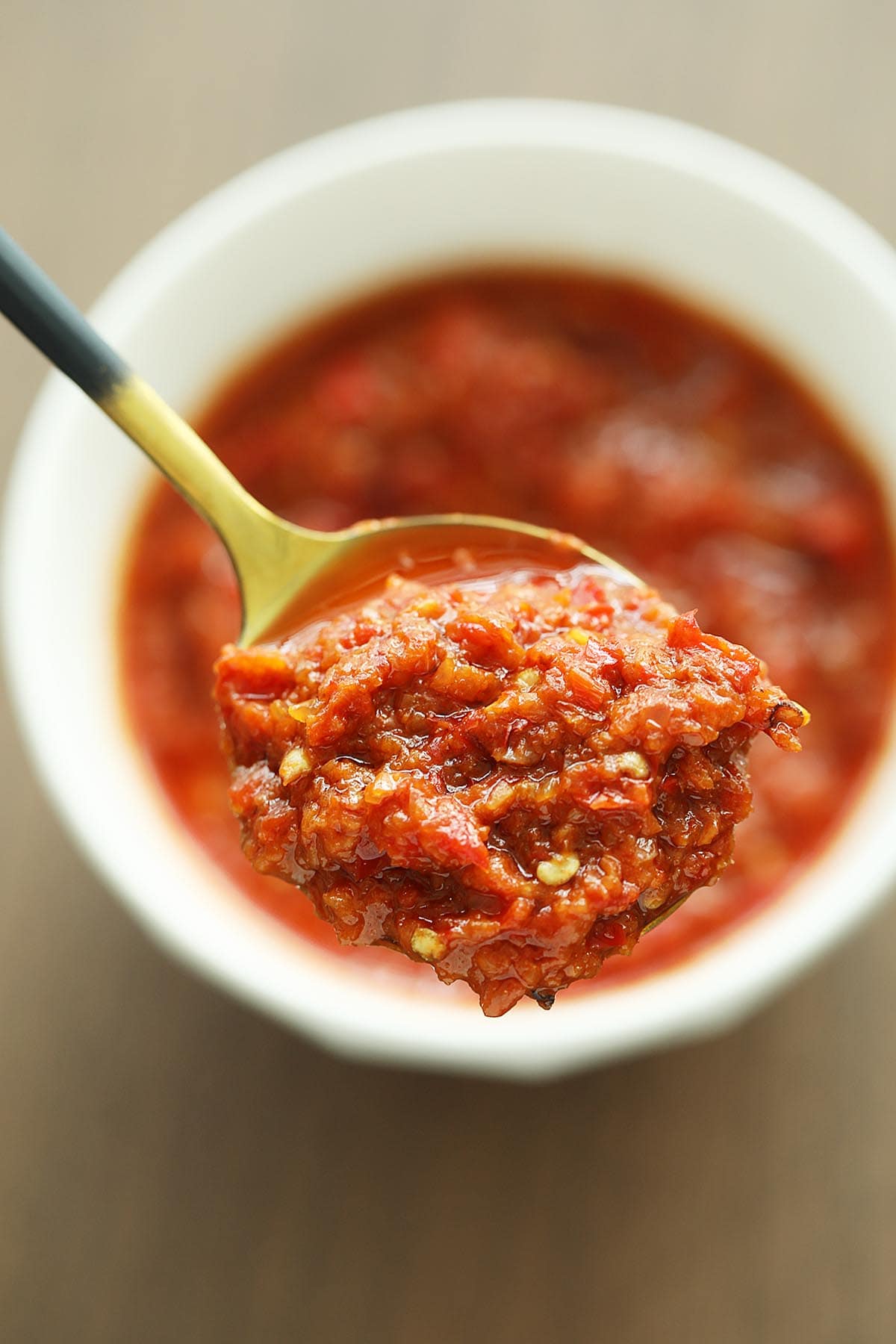
- To make tasty homemade sambal, start with fresh ingredients like chili peppers, shallots, and garlic. Adjust how spicy it is by choosing different kinds of chilies or removing their seeds for less heat.
- Toast the belacan (shrimp paste) for a smoky flavor, but be careful because it can smell strong and pungent, especially during winter months. Please open your windows to allow for air ventilation when you toast belacan.
- Blend all the ingredients thoroughly using a food processor or a traditional mortar and pestle. Ensure everything is finely ground into a smooth paste for the best texture and flavor.
- Cook the sambal paste in oil until it smells good and the oil separates. Taste and adjust the taste with a pinch of salt or sugar. You may also add freshly squeezed calamansi juice to balance the flavor.
- Store the cooked sambal in a sealed container in the refrigerator. Use it whenever your recipe calls for sambal as an ingredient.
Frequently Asked Questions
Depending on the recipe, sambal can vary in spiciness, especially with higher quantities of chili peppers or the use of Thai chilies. My recipe is not mildly spicy, the heat level is adjusted to suit most people. If you want a spicier sambal, just add a few Thai chilies to the recipe.
Sambal is low in calories and rich in vitamins and antioxidants from fresh ingredients used in the recipe.
Yes, you can store sambal in an airtight container in the refrigerator for several weeks. You can also freeze it and it will last for several months.
What To Serve With Sambal
Sambal pairs well with a variety of dishes and can complement different foods. Here are some popular options to serve with sambal:
I hope you enjoy this post as much as I do. If you try my recipe, please leave a comment and consider giving it a 5-star rating. For more easy and delicious recipes, explore my Recipe Index, and stay updated by subscribing to my newsletter and following me on Facebook, Pinterest, and Instagram for new updates.
Other Popular Malaysian Recipes

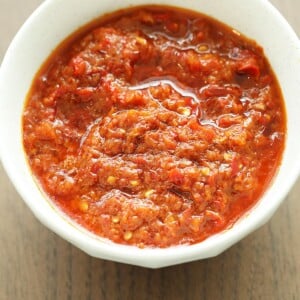
Sambal Recipe
Ingredients
- 20 dried chilies, seeded and soaked to soften
- 10 fresh red chilies, seeded and sliced
- 8 shallots, peeled and chopped
- 4 cloves garlic, peeled and chopped
- 1 teaspoon belacan, break into small bits
- 1/3 cup (6 tablespoons) cooking oil
Instructions
- Use a mortar and pestle to thoroughly pound the sambal ingredients, or opt for a food processor to blend them into a fine, smooth sambal paste.
- Heat oil in a wok over medium heat until hot. Add the sambal paste and stir-fry continuously for a few minutes.
- Make sure the oil separates from the sambal.
- Remove from heat and transfer to a bowl. Let it cool before storing in an airtight container. Keep it in the refrigerator for future use.
Notes
- Toast the belacan (shrimp paste) for a smoky flavor, but be careful because it can smell strong and pungent, especially during winter months. Please open your windows to allow for air ventilation when you toast belacan.
- Blend all the ingredients thoroughly using a food processor or a traditional mortar and pestle. Ensure everything is finely ground into a smooth paste for the best texture and flavor.
- Cook the sambal paste in oil until it smells good and the oil separates. Taste and adjust the taste with a pinch of salt or sugar. You may also add freshly squeezed calamansi juice to balance the flavor.
- Store the cooked sambal in a sealed container in the refrigerator. Use it whenever your recipe calls for sambal as an ingredient.
Nutrition
Nutrition information is automatically calculated, so should only be used as an approximation.
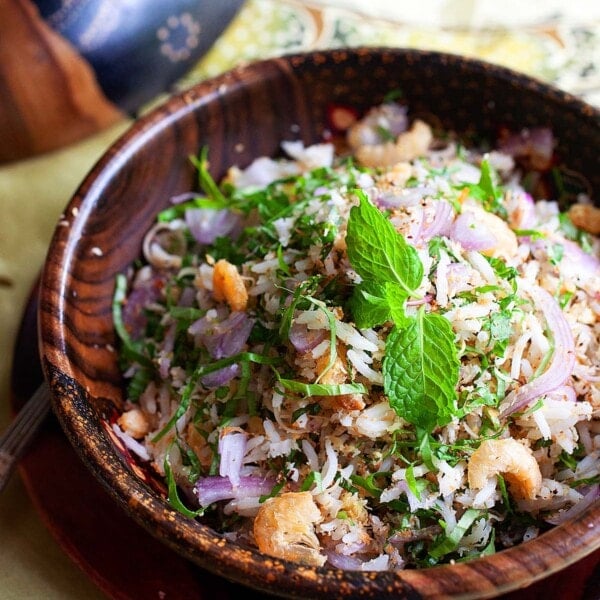
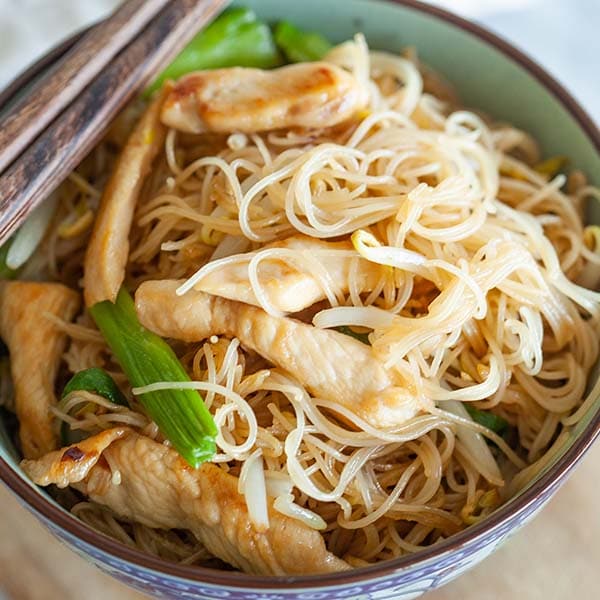
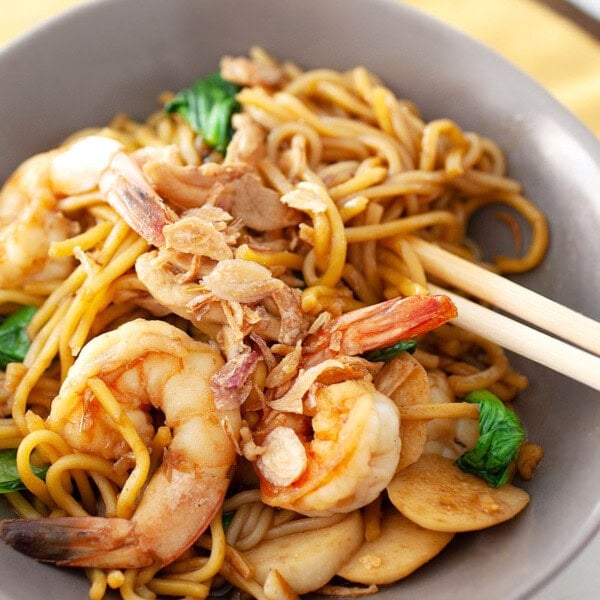
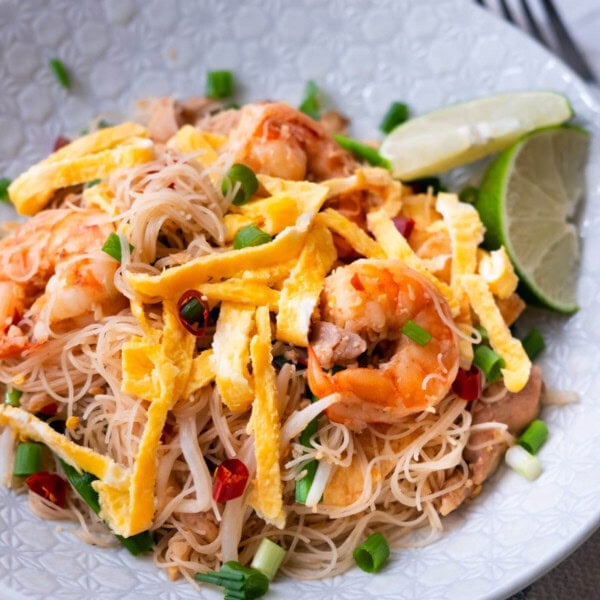






Delicious
Hi Og, thanks for liking my recipe! Try more recipes on my site—they’re all just as delicious. :)
The best chilli sambal recipe 😋
Thanks Martin. You can use it to make a variety of dishes.
How long would you be able to store the sambal? And does it freeze well?
Yes. Please check the FAQ’s on the post: Yes, you can store sambal in an airtight container in the refrigerator for several weeks. You can also freeze it and it will last for several months.
Thank you very much for the reply! Good to know, and sorry for asking a question that’s already answered, I must have overlooked that section when posting my question.
No worries Stian.
Can you tell us what type of dried and fresh chilies we should use for this? There are many different types of peppers, and I have no idea which ones to use.
Hi Al, where are you at? Depending on where you are, your chilies might be different. You can check the post, and look for the ingredient shots. If you are in the US, get dried chili arbol, and fresh red chilies (not jalapeno).
Desert Southwest – Phoenix Az. Thank you, I will look for those! PS I have your book and love it :)